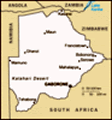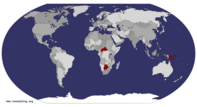Advertisement
Published: December 13th 2014
The background. One frosty evening last December I was hiding from Moscow bustle and hustle at home... I do adore big cities but at the same time I nearly hate them...giving us great opportunities they require too much in return.
Cities are teeming with life: people who are always running somewhere, rumbling roads like a giant beehive inside your head and a whole system of endless tunnels beneath your feet encircle eternally glittering city. And even the sky lined with fancy patterns of planes takes away the last hope for a little piece of space and silence. How do I miss the peace and silence among this urban bustle, how difficult it is to return to life with all these phones and appliances, producing so many noise and interference! I do wish to open the window and fill the air...exciting fresh air...and listen to twittering birds...and look up the sky so blue and endless and know that it belongs only to you. I would like to get to the place where there is no TV, showing us an unreal pretended life and engaging in the intricacies of someone's mind. I'm longing to get to such place where you are alone


with your own thoughts and desires in search of inner peace and harmony. More and more often I escape from the city to my dearest garden, planted by myself, to the fragrant roses and to the bench with a book on it, filled with the new adventures either in the bosom of Africa or in the wilds of the Amazon.
During the cold season of the year when roses peacefully sleep under the snow drift carefully wrapped in spruce branches as in feather duvet, I find my comfort watching Animal Planet programs.
It is just amazing how far and close Africa may be to us.Years ago when I wasn't familiar with the Black continent, it seemed that it is a completely different world - strange, wild and dangerous. But now, having made more than a dozen flights, visited a lot of countries and become acquainted with lots of famous photographers and scientists working on the African land, I begin to feel myself as a part of this unique world.
Here on the screen i can see one of brave guys who is teaching you to survive in a Tanzanian savanna.Quite funny... I wonder how long he will survive
there without the whole team of helpers behind the scenes? Believe me, it is not so cool to wander alone in savannas, filled with African ticks whose bites cause high temperature. Besides, the army of insects can send the famous tse-tse fly, the bite of which is at least very painful. And if it isn't enough for you, there is a great opportunity to get acquainted with the malaria mosquitoes, not mention other parasites living in the water and the meat of wild animals. Don't forget about the danger of meeting with the predators, cattle, elephants, snakes and even poaches.
And now I am watching the Shamvari reserve, this film is about a unique place and a hard daily work to preserve the fragile ecosystem of this reserve. In general, there are a lot of programs for the protection of animals in Africa. One of the largest is the preservation and restoration of the Rino population. Recently the poachers have almost destroyed these animals in several countries in Central Africa. Many of my friends are involved in various projects designed to preserve and restore the number of these powerful and beautiful animals.
Then comes another storyline. A group
of scientists investigates and monitors the movements of great white sharks in the place called Gansbaai on the island Dyer. By the way do you know that almost any shark in this area has its own name and experts can easily distinguish each of them. And here is my famous skipper Hennie Otto. How many times we have spent in this waters photo hunting this beautiful predator and its prey — a seal.
But that night I saw something completely new and daring, that caught my attention at once: the brave scientist challenged the predator- "The Queen of the seas and oceans".He was one-on-one with the great white shark without any protection and a cell! Nose to nose, eye to eye! He even dared to ride the predator as a tamed dolphin! My delight, surprise and admiration of this man was boundless! And the name of this not very young hero was Amus Nahum.
It took me some time to find this scientist, and in the end I received the long-awaited answer from him:"You are in my team". As it turned out Amos was a legendary and rare wildlife photographer and flora and fauna expert both the under
and above the water world. More than once he has been asked to lead the expeditions of National Geographical society. He has produced documentaries for such channels as Discovery, BBC, CNN. He was the team leader for National Geographic. Amos's photos and essays are published in hundreds of publications around the world. He is the winner of numerous competitions and moreover, he is the head of the jury at various photography contests. Besides huge sharks the scientist is working with polar bears, killer whales, sea lions, leopard seals, anacondas and the Nile crocodiles. But for these "intimate" acquaintances is given its special time of the year and location.
You can't even imagine my joy when Amos sent me a special program-plan of my travels with him for the next year! I decided not to postpone and immediately started my preparations for the adventure. The scientist agreed to take me to this exciting journey under condition that I would have professional scuba skills and feel myself under the water like a fish. Ooops... There you are! To tell the truth I am not a good swimmer on the surface as I can't stand getting water into my ears... but underwater..it
must be even worse....But if he needs PADI - I am going to get it. Just in time- in two weeks I leave for Fiji.
Honestly speaking, I didn't even realize that to accomplish this task would be so difficult. To start with, the instructor having put a multi-kg equipment on me ordered to jump into the water. Is he crazy? Jump? I could hardly move! Above all, at a depth of 7 meters he took my air regulator and not explaining anything asked to insert it again. I drank too much water, while trying to get to the surface...
During the following days I had to overcome my fears, some injuries from sharp corals and drink more than one liter of water before I learned to feel confident among the colourful fish. Now when there are a lot of records in my dive log (a dive log book is used by a scuba divers to record the details of their dives- approx.) I smile, remembering those painful days of mine. And now I can say for sure that every overcoming yourself and your fears makes you stronger, strenthens your willpower and trains the character.
And here
I am packing suits to overcome one more of my fears in a company of a deeply respected scientist, photographer and the bravest man whom I have ever met and knew - Amos Nachum. We are going to look into the eyes of the most dangerous predator in the world - the Nile crocodile! You may believe me, just few people have ever done it...We are going to immerse into the natural habitat of the predator, into the cold waters of the African Okavango river, somewhere very far in Botswana.
The rules attached to the letter-instruction said that I should swim next to Amos at a distance of no more than two metres. There should be a complete buoyancy control and a strict adherence to rules and regulations of diving. The tactile contact with the river monster is permitted under no circumstances. It is nessesary to have all the equipment that allow you to stay in the water long enough and feel yourself safe and protected. I wonder if I meet a giant reaching six meters in length and 900 kg in weight how it is possible in general "to feel yourself safe and protected"?! And don't worry I
don't think I'll have any idea of touching it at this moment! The next paragraph:"Stroboscopic light sources and illumination for video are recommended to use during the dive.You will be so close to the predator that will see the reflection of the light from crocodiles's shining eyes, its white teeth and so on." It would sound rather amusing if I were not so scary... And what do they mean by "so on"? What else can reflect the light? That one who had been recently eaten?...
Nile crocodiles are called "cannibals" because they live close to human settlements and kill hundreds and sometimes thousand of people per year. According to recent research work the monsters attack from 275 to 745 times a year, and 63% of them became fatal to humans. Thus, the Nile crocodile may be considered as the most dangerous predator for a human being.
The method of work.
Amos works with crocodiles only during winter months. They are June and July in Africa. The water temperature at this time is only 14 degrees Celsius, and the crocodiles prefer to bask in the sun. During this period the river monsters not so active and it helps us
to detect them.
We will begin the search for crocodiles at 9 a.m. And as soon as we reach the goal we immediately have to immerse into the water. It is forbidden to be more than some seconds on the surface as it is a very dangerous zone. We quickly get down to the bottom of the river and start our search of the most aggressive and the most adapted predator in the world, who is capable to kill all living things in its environment and having a unique gasp among all the animals and even sharks!
It is nessesary to mention that we are going to live on a tiny island having lost somewhere in the river, in a tent camp specially made for us. And even this fact by itself is a real adventure as the waters surrounding us are teeming not only with crocodiles but hippos as well! And it also well-known that they pose a serious danger to humans .
We are going to survive on this island for at least eight days and during this time we'll dive more than 30 times into cold and unfriendly waters of the Okavango.
Well...the
expedition in search of the largest African river monster begins...Soon you'll know everything...
And do you remember how all this started?..just with the lack of silence and fresh air and a small book forgotten on a bench among beautiful roses...
Advertisement
Tot: 0.194s; Tpl: 0.012s; cc: 7; qc: 77; dbt: 0.078s; 1; m:domysql w:travelblog (10.17.0.13); sld: 1;
; mem: 1.3mb
















